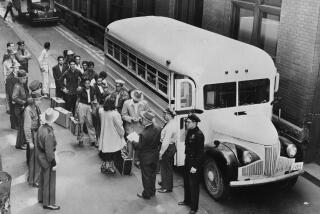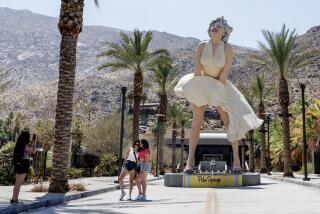Junipero Serra statue to be moved away from Ventura City Hall
Sainthood may reserve a prominent space in heaven for California missionary Junipero Serra, but a statue of the 18th century Roman Catholic priest will soon no longer have a home in front of Ventura City Hall.
Ventura Mayor Matt LaVere, representatives from the Barbareño/Venureño Band of Mission Indians and Father Tom Elewaut, pastor of nearby Mission San Buenaventura, issued a joint statement Thursday agreeing to take down the statue and have it “moved to a more appropriate non-public location.”
“I always knew that this moment, despite all the issues our people have faced, would happen,” Chief Julie Tumamait Stenslie, whose Barbareño/Venureño Band comprises Chumash members, said in a phone interview Thursday evening. “We’re constantly fighting to correct our history, and if there was ever a time to speak up, the time was now.”
While there has been a global movement to remove statues from England to New Zealand, with a focus on Confederate statues in the United States, momentum has been growing in California.
In the last few days, a likeness of explorer Christopher Columbus was taken down in San Francisco, while a statue of California Gold Rush colonizer John Sutter was defaced and then removed in Sacramento.
Thursday’s joint statement confirmed an agreement to move the statue of Serra, though where and when is still murky.
“A historic decision such as this must involve the Ventura City Council, the voices of the Chumash tribe and residents of Ventura,” the statement read.
Serra, born on the Spanish island of Mallorca in 1713, is a controversial figure in California, particularly among indigenous tribes.
The Franciscan priest founded nine of 21 missions throughout the state and is perhaps the person most responsible for spreading Roman Catholicism into the Western United States, which then was Spanish territory.
Serra’s mission system was responsible for the destruction of several tribes, often through the introduction of foreign diseases. Tribes that did survive, such as the Chumash, still suffered greatly and were often forced into building the missions.
The mission system not only pressured indigenous peoples into becoming Catholic, but pressured them to assimilate and, therefore, lose their cultural ways.
Despite this history, Los Angeles Archbishop José Gómez referred to Serra as one of his “spiritual heroes.” Pope Francis canonized him a saint in 2015.
Serra’s bronzed, roughly nine-foot statue resides in a pristine location in a small park in front of City Hall. Serra has his back to the government building and gazes down upon California Street with a view of the ocean.
An original statue was commissioned in the 1930s but wore down and was replaced by the modern version in 1989.
“I just don’t believe many people understand what it means to our people to pass by City Hall and see that statue and the pain it’s caused and causes to do this day,” said Stenslie, who noted that Chumash people had lived in the area for thousands of years prior to Serra’s arrival. “We in Ventura are a much more diverse community and deserve to be represented by someone else.”
A local online petition advocating the statue’s removal garnered over 5,000 signatures as of Thursday evening.
Camarillo resident Ben Leaños, 23, a Ventura High graduate, is one a few organizers preparing a protest for Saturday at 1 p.m. near the statue.
The original goal of the protest was to pressure city officials to remove the statue. Now that officials have conceded quicker than expected, Leaños said the demonstration will focus on making sure the City Council and mayor move swiftly.
“Just because we don’t have Confederate generals or slavery in California like in other parts of the country doesn’t mean we don’t have monuments to white supremacy and genocide,” Leaños said. “We’re going to be out there on Saturday to say thank you, but also to remind the city government that we’re going to be watching them.”
More to Read
Sign up for Essential California
The most important California stories and recommendations in your inbox every morning.
You may occasionally receive promotional content from the Los Angeles Times.











